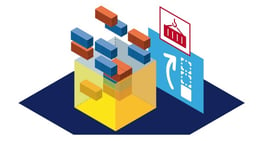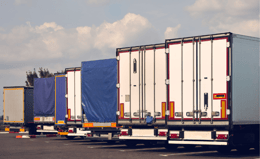Pump Free Fuel from Your Supply Chain
Keith LaBotz - October 27, 2022

A dollar saved is a dollar earned. The same is true for every liter of diesel saved when transporting freight, and supply chains can use some extra fuel right now.
Soaring fuel prices surpassed the driver shortage as the trucking industry’s top concern this year, according to the American Transportation Research Institute’s Critical Issues in the Trucking Industry 2022 report. That’s notable because the driver shortage has held this position for the past five years.

Given current events and the trajectory of policymakers, supply chain solutions that generate fuel savings are attractive. The financial impact of these savings is compelling:
- With an average corporate tax rate of 25.7% in the US (29.9% in Germany), a dollar saved translates to a $1.26 increase in earnings.
- The diesel price (Oct 25, 2022) in the US and Germany is 8.06 USD. A 25% reduction in transportation costs is the equivalent of purchasing diesel at 6.05 USD. Nice discount.
- Lower fuel consumption reduces Greenhouse gas emissions without a significant expenditure like purchasing EVs or more fuel-efficient trucks.
Cost savings are like nontaxable income, going straight to a company’s bottom line, and that’s welcome news in a global recession. Transportation improvements offer the most direct path to these savings.
Focus On Transportation
Effective transportation management results from an effective enterprise business process, and a good supply chain model makes this easier to create.
Transportation is the core of a supply chain. Every function in an enterprise business process ultimately begins or ends with a shipment in the supply chain. In essence, all business processes exist to support supply chain transportation.
When transportation is the focus of your supply chain, it reveals a model that leads to highly effective transportation management:
- All enterprise processes support supply chain transportation.
- Efficient processes eliminate excess resources, costs, risks, and steps in the business process.
- Optimization results from aligning efficient processes around a common goal: efficient transportation of shipments.
- Transportation efficiency and enterprise efficiency are inseparable.
Practice Lean Logistics
Lean logistics focuses on eliminating waste and targets unnecessary efforts, costs, and resources in execution. Because every enterprise process supports transportation, increasing logistics efficiency results in leaner transportation:
- Fewer vehicles are required.
- Fewer miles are driven.
- Less shipping and receiving labor.
- Increased accuracy eliminates return shipments.
- Waste is removed, and capacity is fully utilized.
- More fuel-efficient modes of transportation are used.
With a focus on transportation and lean logistics in hand, there are several improvements your company can target that will generate significant fuel savings in short order.
Pool Distribution
Pool distribution consolidates shipments from multiple shippers into a truck that delivers each shipment along the way to the final destination. Combining individual LTL (less than truckload) shipments into a full truckload means no LTL break bulk terminals and transfers. Transit times and pricing improve, and significantly less labor and fuel are involved.
Order Consolidation
Grouping orders for a customer, and then packing them into a single shipment eliminates the pickups, linehaul transport, and deliveries that would’ve occurred otherwise. Consolidation also minimizes the use of packaging materials and usually enables the carrier to improve the utilization of dock and trailer space.
Intermodal Transportation
Intermodel transportation combines the efficiency of rail service with the agility of truck services. Shipments loaded into containers are transported by truck to a rail yard and loaded onto a train. The containers travel by train for the long haul portion of the trip and then are transferred back onto trucks for the “last mile” of transportation.

- According to CSX, one gallon of diesel will transport one ton of freight 450 miles via rail.
- With the average big rig getting 6 miles per gallon, the same move by truck costs 90 gallons of diesel, plus it dedicates a driver for the roundtrip of 900 and may deadhead an empty trailer on return.
- CSX estimates converting 10% of long-haul highway freight to rail would save 12 billion gallons of diesel fuel annually.
Routing Optimization
Routing optimization can consolidate orders, and trips, map the most economical routes and avoid traffic congestion. Transportation savings of 20% are typical for a routing solution.
Load Optimization
Load optimization utilizes transportation capacity and speeds up the loading and unloading of trailers. Minimizing the time spent at pick-ups and deliveries improves productivity. With less idle time, freight capacity and response times increase, allowing for additional shipments. The result is corporate fleets can reduce the number of vehicles.
Transportation and S&OP Planning
Transportation planning identifies opportunities for order and shipment consolidation and slower, economical transportation, like intermodal. When combined with S&OP planning, a company can extend transportation planning further into the future and collaborate schedules to increase these savings opportunities.
Conclusion
Increasing transportation efficiency is like pumping free fuel from your company's supply chain. Shipping operations spend less on gas, and the savings go straight to your company’s bottom line.
The flexis AG offers the solutions discussed in this article, and we welcome a discussion on how it can benefit your company.
INTERESTED IN MORE INFORMATION?
LATEST POSTS
- Understand Circular Economy in The Manufacturing Industry
- How Can Industry 4.0 IT Integration Be Achieved Smoothly?
- The Significance of Order Sequencing in Discrete Manufacturing
- How to improve your Supply Chain Management: The Power of Control Towers
- Optimizing Human Resource Scheduling in Manufacturing: A Technological Approach



